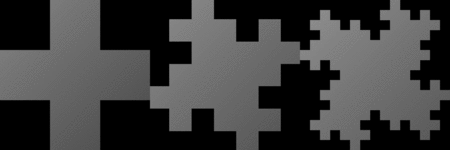Koch snowflake
The Koch snowflake (also known as the Koch curve, Koch star, or Koch island[1][2]) is a fractal curve and one of the earliest fractals to have been described. It is based on the Koch curve, which appeared in a 1904 paper titled "On a Continuous Curve Without Tangents, Constructible from Elementary Geometry"[3] by the Swedish mathematician Helge von Koch.

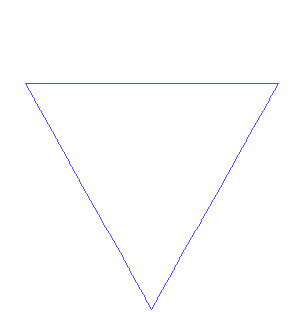
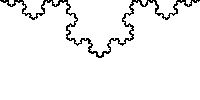

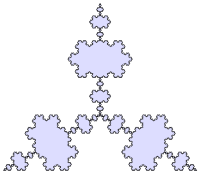
The Koch snowflake can be built up iteratively, in a sequence of stages. The first stage is an equilateral triangle, and each successive stage is formed from adding outward bends to each side of the previous stage, making smaller equilateral triangles. The areas enclosed by the successive stages in the construction of the snowflake converge to 8/5 times the area of the original triangle, while the perimeters of the successive stages increase without bound. Consequently, the snowflake encloses a finite area, but has an infinite perimeter.
Construction
The Koch snowflake can be constructed by starting with an equilateral triangle, then recursively altering each line segment as follows:
- divide the line segment into three segments of equal length.
- draw an equilateral triangle that has the middle segment from step 1 as its base and points outward.
- remove the line segment that is the base of the triangle from step 2.
The first iteration of this process produces the outline of a hexagram.
The Koch snowflake is the limit approached as the above steps are followed indefinitely. The Koch curve originally described by Helge von Koch is constructed using only one of the three sides of the original triangle. In other words, three Koch curves make a Koch snowflake.
A Koch curve–based representation of a nominally flat surface can similarly be created by repeatedly segmenting each line in a sawtooth pattern of segments with a given angle.[4]
Properties
Perimeter of the Koch snowflake
Each iteration multiplies the number of sides in the Koch snowflake by four, so the number of sides after n iterations is given by:
If the original equilateral triangle has sides of length s, the length of each side of the snowflake after n iterations is:
an inverse power of three multiple of the original length. The perimeter of the snowflake after n iterations is:
The Koch curve has an infinite length, because the total length of the curve increases by a factor of 4/3 with each iteration. Each iteration creates four times as many line segments as in the previous iteration, with the length of each one being 1/3 the length of the segments in the previous stage. Hence, the length of the curve after n iterations will be (4/3)n times the original triangle perimeter and is unbounded, as n tends to infinity.
Limit of perimeter
As the number of iterations tends to infinity, the limit of the perimeter is:
since |4/3| > 1.
An ln 4/ln 3-dimensional measure exists, but has not been calculated so far. Only upper and lower bounds have been invented.[5]
Area of the Koch snowflake
In each iteration a new triangle is added on each side of the previous iteration, so the number of new triangles added in iteration n is:
The area of each new triangle added in an iteration is 1/9 of the area of each triangle added in the previous iteration, so the area of each triangle added in iteration n is:
where a0 is the area of the original triangle. The total new area added in iteration n is therefore:
The total area of the snowflake after n iterations is:
Collapsing the geometric sum gives:
Limits of area
The limit of the area is:
since |4/9| < 1.
Thus, the area of the Koch snowflake is 8/5 of the area of the original triangle. Expressed in terms of the side length s of the original triangle, this is:[6]
Solid of revolution
The volume of the solid of revolution of the Koch snowflake about an axis of symmetry of the initiating equilateral triangle of unit side is [7]
Other properties
The Koch snowflake is self-replicating with six smaller copies surrounding one larger copy at the center. Hence, it is an irrep-7 irrep-tile (see Rep-tile for discussion).
The fractal dimension of the Koch curve is ln 4/ln 3 ≈ 1.26186. This is greater than that of a line (=1) but less than that of Peano's space-filling curve (=2).
The Koch curve is continuous everywhere, but differentiable nowhere.
Tessellation of the plane
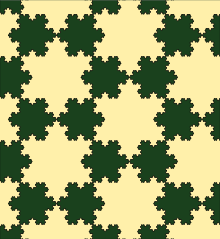
It is possible to tessellate the plane by copies of Koch snowflakes in two different sizes. However, such a tessellation is not possible using only snowflakes of one size. Since each Koch snowflake in the tessellation can be subdivided into seven smaller snowflakes of two different sizes, it is also possible to find tessellations that use more than two sizes at once.[8] Koch snowflakes and Koch antisnowflakes of the same size may be used to tile the plane.
Thue–Morse sequence and turtle graphics
A turtle graphic is the curve that is generated if an automaton is programmed with a sequence. If the Thue–Morse sequence members are used in order to select program states:
- If t(n) = 0, move ahead by one unit,
- If t(n) = 1, rotate counterclockwise by an angle of π/3,
the resulting curve converges to the Koch snowflake.
Representation as Lindenmayer system
The Koch curve can be expressed by the following rewrite system (Lindenmayer system):
- Alphabet : F
- Constants : +, −
- Axiom : F
- Production rules:
- F → F+F--F+F
Here, F means "draw forward", - means "turn right 60°", and + means "turn left 60°".
To create the Koch snowflake, one would use F--F--F (an equilateral triangle) as the axiom.
Variants of the Koch curve
Following von Koch's concept, several variants of the Koch curve were designed, considering right angles (quadratic), other angles (Cesàro), circles and polyhedra and their extensions to higher dimensions (Sphereflake and Kochcube, respectively)
| Variant (dimension, angle) | Illustration | Construction |
|---|---|---|
| ≤1D, 60-90° angle |  Cesàro fractal (85°) | The Cesàro fractal is a variant of the Koch curve with an angle between 60° and 90°.  First four iterations of a Cesàro antisnowflake (four 60° curves arranged in a 90° square) |
| ≈1.46D, 90° angle |  Quadratic type 1 curve |  First two iterations |
| 1.5D, 90° angle | 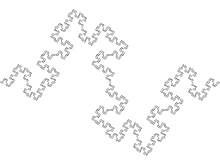 Quadratic type 2 curve | Minkowski Sausage[9]  First two iterations. Its fractal dimension equals 3/2 and is exactly half-way between dimension 1 and 2. It is therefore often chosen when studying the physical properties of non-integer fractal objects. |
| ≤2D, 90° angle |  Third iteration | Minkowski Island 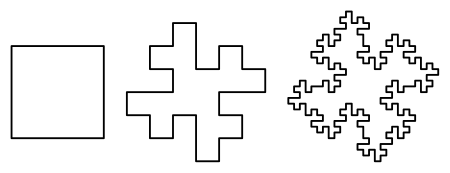 Four quadratic type 2 curves arranged in a square |
| ≈1.37D, 90° angle | 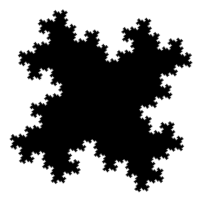 Quadratic flake | |
| ≤2D, 90° angle | Quadratic antiflake | Anticross-stitch curve, the quadratic flake type 1, with the curves facing inwards instead of outwards (Vicsek fractal) |
| ≈1.49D, 90° angle | 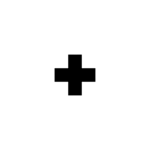 Quadratic Cross | Another variation. Its fractal dimension equals ln 3.33/ln √5 = 1.49. |
| ≤2D, 90° angle |  Quadratic island[14] |  Quadratic curve, iterations 0, 1, and 2; dimension of ln 18/ln 6≈1.61 |
| ≤2D, 60° angle |  von Koch surface | 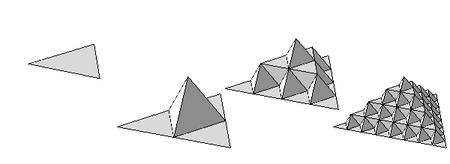 First three iterations of a natural extension of the Koch curve in two dimensions. |
| ≤2D, 90° angle | .png) Quadratic type 1 surface | Extension of the quadratic type 1 curve. The illustration at left shows the fractal after the second iteration  Animation quadratic surface |
| ≤3D, any | .jpg) Koch curve in 3D | A three-dimensional fractal constructed from Koch curves. The shape can be considered a three-dimensional extension of the curve in the same sense that the Sierpiński pyramid and Menger sponge can be considered extensions of the Sierpinski triangle and Sierpinski carpet. The version of the curve used for this shape uses 85° angles. |
Squares can be used to generate similar fractal curves. Starting with a unit square and adding to each side at each iteration a square with dimension one third of the squares in the previous iteration, it can be shown that both the length of the perimeter and the total area are determined by geometric progressions. The progression for the area converges to 2 while the progression for the perimeter diverges to infinity, so as in the case of the Koch snowflake, we have a finite area bounded by an infinite fractal curve.[15] The resulting area fills a square with the same center as the original, but twice the area, and rotated by π/4 radians, the perimeter touching but never overlapping itself.
The total area covered at the nth iteration is:
while the total length of the perimeter is:
which approaches infinity as n increases.
See also
- List of fractals by Hausdorff dimension
- Gabriel's Horn (infinite surface area but encloses a finite volume)
- Gosper curve (also known as the Peano–Gosper curve or flowsnake)
- Osgood curve
- Self-similarity
- Teragon
- Weierstrass function
- Coastline paradox
References
- Addison, Paul S. (1997). Fractals and Chaos: An Illustrated Course. Institute of Physics. p. 19. ISBN 0-7503-0400-6.
- Lauwerier, Hans (1991). Fractals: Endlessly Repeated Geometrical Figures. Translated by Gill-Hoffstädt, Sophia. Princeton University Press. p. 36. ISBN 0-691-02445-6.
Mandelbrot called this a Koch island.
- von Koch, Helge (1904). "Sur une courbe continue sans tangente, obtenue par une construction géométrique élémentaire". Arkiv för Matematik (in French). 1: 681–704. JFM 35.0387.02.
- Alonso-Marroquin, F.; Huang, P.; Hanaor, D.; Flores-Johnson, E.; Proust, G.; Gan, Y.; Shen, L. (2015). "Static friction between rigid fractal surfaces" (PDF). Physical Review E. 92: 032405. doi:10.1103/PhysRevE.92.032405. — Study of fractal surfaces using Koch curves.
- Zhu, Zhi Wei; Zhou, Zuo Ling; Jia, Bao Guo (October 2003). "On the Lower Bound of the Hausdorff Measure of the Koch Curve". Acta Mathematica Sinica. 19 (4): 715–728. doi:10.1007/s10114-003-0310-2.
- "Koch Snowflake". ecademy.agnesscott.edu.
- McCartney, Mark (2020-04-16). "The area, centroid and volume of revolution of the Koch curve". International Journal of Mathematical Education in Science and Technology. 0 (0): 1–5. doi:10.1080/0020739X.2020.1747649. ISSN 0020-739X.
- Burns, Aidan (1994). "Fractal tilings". Mathematical Gazette. 78 (482): 193–6. JSTOR 3618577..
- Paul S. Addison, Fractals and Chaos: An illustrated course, p. 19, CRC Press, 1997 ISBN 0849384435.
- Weisstein, Eric W. (1999). "Minkowski Sausage", archive.lib.msu.edu. Accessed: 21 September 2019.
- Pamfilos, Paris. "Minkowski Sausage", user.math.uoc.gr/~pamfilos/. Accessed: 21 September 2019.
- Weisstein, Eric W. "Minkowski Sausage". MathWorld. Retrieved 22 September 2019.
- Mandelbrot, B. B. (1983). The Fractal Geometry of Nature, p.48. New York: W. H. Freeman. ISBN 9780716711865. Cited in Weisstein, Eric W. "Minkowski Sausage". MathWorld. Retrieved 22 September 2019..
- Appignanesi, Richard; ed. (2006). Introducing Fractal Geometry. Icon. ISBN 978-1840467-13-0.
- Demonstrated by James McDonald in a public lecture at KAUST University on January 27, 2013. "Archived copy". Archived from the original on 2013-01-12. Retrieved 2013-01-29.CS1 maint: archived copy as title (link) retrieved 29 January 2013.
Further reading
- Kasner, Edward; Newman, James (2001) [1940]. "IX Change and Changeability § The snowflake". Mathematics and the Imagination. Dover Press. pp. 344–351. ISBN 0-486-41703-4.
External links
| External video | |
|---|---|
| Wikimedia Commons has media related to Koch curve. |
| Wikimedia Commons has media related to Koch snowflake. |
- (2000) "von Koch Curve", efg's Computer Lab at the Wayback Machine (archived 20 July 2017)
- The Koch Curve poem by Bernt Wahl, Wahl.org. Retrieved 23 September 2019.
- Weisstein, Eric W. "Koch Snowflake". MathWorld. Retrieved 23 September 2019.
- "7 iterations of the Koch curve". Wolfram Alpha Site. Retrieved 23 September 2019.
- "Square Koch Fractal Curves". Wolfram Demonstrations Project. Retrieved 23 September 2019.
- "Square Koch Fractal Surface". Wolfram Demonstrations Project. Retrieved 23 September 2019.
- Application of the Koch curve to an antenna
- A WebGL animation showing the construction of the Koch surface, tchaumeny.github.io. Retrieved 23 September 2019.
- "A mathematical analysis of the Koch curve and quadratic Koch curve" (PDF). Archived from the original (pdf) on 26 April 2012. Retrieved 22 November 2011.
